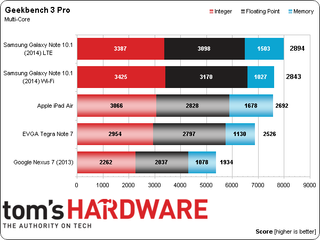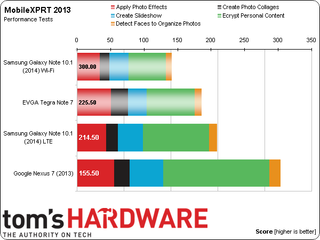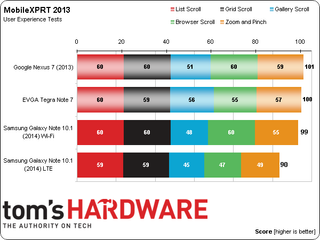Samsung Galaxy Note 10.1 (2014 Edition) Review: Wi-Fi Vs. LTE
Today's review of Samsung's Galaxy Note 10.1 (2014 Edition) includes the LTE-capable and Wi-Fi-only tablets, allowing us to compare Samsung's own Exynos 5 Octa platform to Qualcomm's Snapdragon 800. Can either configuration usurp Apple's iPad Air?
Why you can trust Tom's Hardware
Results: CPU Core Benchmarks
AnTuTu
AnTuTu is an Android system benchmark designed to test the performance capabilities of four major aspects of mobile devices: graphics (encompassing 2D, UI, and basic 3D); CPU (fixed, floating-point, and threading); RAM (read and write); and I/O (read and write).

The Tegra Note 7 and both Galaxy Note 10.1 models fall within striking distance of one another; the two Note 10.1 devices benchmark ahead of the Nexus 7 (2013) by a very wide margin.
While it's obvious that the Snapdragon S4 Pro-powered Nexus 7 (2013) would trail the other tablets, the performance difference between the Tegra Note 7 and pair of Galaxy Note 10.1s is quite narrow. With near-even UX, RAM, CPU, and I/O capabilities, the gap seems to mostly come from GPU performance. Unsurprisingly, the Tegra 4-powered Note 7 comes out with the best GPU score, followed closely by the ARM Mali-T626-powered Note 10.1 (2014) Wi-Fi, and then the Adreno 330-powered Note 10.1 (2014) LTE.
While the Wi-Fi and LTE models seem closely matched, remember that AnTuTu tests only a very basic implementation of 3D graphics, and we expect the gap to widen as the graphics tests become more intense.
Basemark OS II
Rightware is an experienced multiplatform benchmark developer. The company leverages this experience with Basemark OS II, an all-in-one tool designed for measuring the overall performance of mobile devices. The test is available on all major smartphone platforms, including Android, iOS, and Windows Phone 8. Basemark OS II uses a similar approach to Geekbench, but focuses on more application-specific areas, particularly User eXperience (UX), Web browsing, and rendering performance.

The Basemark OS II scores are quite interesting, as Apple's iPad Air beats the Snapdragon 800-powered Note 10.1 (2014) LTE by a slim margin. Both have a healthy lead over the Exynos 5 Octa (5420)-powered Note 10.1 (2014 Edition) Wi-Fi, as well as the almost one-year-old Nexus 7 (2013). What's most surprising is that the Tegra 4-powered Note 7 falls far behind every other tablet, even on graphics performance.
In this metric, the LTE model's Adreno 330 blows away all other GPUs to the point that even the iPad Air, with its noticeably superior System and Web scores, just barely beats the Snapdragon 800-powered Note 10.1 (2014) LTE. The Exynos Octa-powered Note 10.1 (2014) Wi-Fi's score falls somewhere between the Note 10.1 (2014) LTE and Nexus 7 (2013). It seems like Nvidia's Tegra 4 simply doesn't run well in Basemark OS II, as it performs quite badly in the graphics portion of the benchmark, resulting in a score less than half that of the top two tablets.
Geekbench 3
Primate Labs' Geekbench is somewhat of an industry standard due to its long-standing database and wide cross-platform compatibility (Windows/OS X/Linux/iOS/Android). This simple system benchmark produces two sets of scores: single- and multi-threaded. For each, it runs a series of tests in three categories: Integer, Floating Point, and Memory. The individual results are used to calculate category scores, which, in turn, generate overall Geekbench scores.

The iPad Air benchmarks better by a country mile in the Single-Core test. This is one of the stronger scores for Apple's A7 SoC, dominating in Integer and Floating Point calculations, as well as Memory testing.
Both Note 10.1 (2014) units, as well as the Tegra Note 7, finish closely behind Apple's flagship tablet with scores in the mid-900s. Finally, the Nexus 7 2013 finishes with a much lower score, as expected, though not by nearly as much, since this test holds no graphics component.

Analysis gets more complicated in the Multi-Core scores, where the Note 7 trails Apple's iPad Air ever so slightly. Samsung's Exynos-powered Note 10.1 (2014 Edition) Wi-Fi, on the other hand, bests the iPad Air ever so slightly, while the Snapdragon 800-powered Note 10.1 (2014 Edition) LTE leads, scoring just short of 3000 points.
MobileXPRT 2013
Principled Technologies' MobileXPRT 2013 is a modern SoC benchmark for Android. It consists of 10 real-world test scenarios split into two categories of testing: Performance and User Experience. The Performance suite contains five tests: Apply Photo Effects, Create Photo Collages, Create Slideshow, Encrypt Personal Content, and Detect Faces to Organize Photos.

The Snapdragon 800-powered Note 10.1 (2014 Edition) Wi-Fi leads with 300 points, while the Snapdragon-powered LTE version follows closely behind at 214.5 points. The Tegra Note 7 trails significantly, achieving 206.5 points.
The User Experience suite also has five tests: List Scroll, Grid Scroll, Gallery Scroll, Browser Scroll, and Zoom and Pinch. These results are measured in frames per second. The category scores are generated by taking a geometric mean of the ratio between a calibrated machine (Motorola's Droid Razr M) and the test device for each subtest.

To many people, this is the most important test to look at, as User Experience measures the responsiveness of the most common gestures performed by users on their smartphones. Many purists clamor for the stock Android experience, often for its responsiveness. And these results might be the most convincing evidence for wanting a stock device. The much older Nexus 7 and Tegra Note 7—both of which run stock versions of Android—score better than both versions of the Note 10.1 (2014 Edition). There is a sharp difference between the two Galaxy devices. The often-better-performing Qualcomm Snapdragon 800 loses harshly to Samsung's Exynos 5 Octa. We'll have to chalk that one up to Samsung's production of more efficient drivers for its own in-house chips.
Current page: Results: CPU Core Benchmarks
Prev Page Benchmark Suite And Test System Specs Next Page Results: GPU Core BenchmarksStay on the Cutting Edge
Join the experts who read Tom's Hardware for the inside track on enthusiast PC tech news — and have for over 25 years. We'll send breaking news and in-depth reviews of CPUs, GPUs, AI, maker hardware and more straight to your inbox.
-
blackmagnum The only possible way Samsung mobile devices can be a worthwhile alternative to Apple is when they ditch the every-man Android and create their own tightly controlled/ managed OS like Apple. Do that and consumers might not feel like they're just buying the Samsung for the hardware.Reply -
Farrwalker On page 7. Results: CPU Core Benchmarks:Reply
Your bar graph "MobileXPRT 2013" seems to be in error.
For example, the text says, "Note 10.1 (2014 Edition) Wi-Fi leads with 300 points . . ."
but the bar is the shortest and indicates less than 150 points.
-
blueer03 You need to proofread this big time. From page 9:Reply
Samsung's Exynos-based Note 10.1 (2014 Edition) Wi-Fi holds its own against the Tegra Note 7, while the LTE version of the Note 10.1 (2014 Edition) again falls significantly behind its Snapdragon 800-powered Wi-Fi counterpart.
And this happens all throughout. The LTE is a Snapdragon, the Wifi is an Exynos. Keep repeating that to yourself as you re-write the descriptions and it will make this easier to read. -
Kevin Harrelson We got one of these for my son (age 13) to help with his school work. We got it from Best Buy and got the extended warranty. Both sound dumb, but it was actually a good move! The backlight has gone out on this thing TWICE. I happen to think that it is a lovely little tablet, but the backlight is a major reliability issue.Reply -
adamovera ReplyOn page 7. Results: CPU Core Benchmarks:
This benchmark's sub-tests produce scores in seconds (lower is better), and the overall score is given as a typical higher-is-better score, so the lowest bar indicates the fastest completion. Sorry about the confusion, I'll look into other ways to represent this test.
Your bar graph "MobileXPRT 2013" seems to be in error. For example, the text says, "Note 10.1 (2014 Edition) Wi-Fi leads with 300 points . . ." but the bar is the shortest and indicates less than 150 points.
-
adamovera ReplyYou need to proofread this big time. From page 9:
Good catch, thanks! Fixed.
Samsung's Exynos-based Note 10.1 (2014 Edition) Wi-Fi holds its own against the Tegra Note 7, while the LTE version of the Note 10.1 (2014 Edition) again falls significantly behind its Snapdragon 800-powered Wi-Fi counterpart.
And this happens all throughout. The LTE is a Snapdragon, the Wifi is an Exynos. Keep repeating that to yourself as you re-write the descriptions and it will make this easier to read. -
Tomtompiper The 2014 is almost 5 months old and has been superseded by the Amoled screened Galaxy Tab S 10.1 which wipes the floor with the opposition. http://www.gsmarena.com/samsung_galaxy_tab_s_105-review-1097.php Do try to keep up!Reply -
adamovera ReplyThe 2014 is almost 5 months old and has been superseded by the Amoled screened Galaxy Tab S 10.1 which wipes the floor with the opposition. http://www.gsmarena.com/samsung_galaxy_tab_s_105-review-1097.php Do try to keep up!
Actually, you'd think this has been phased out, but it's the current 10-inch Galaxy "Note" product, meaning it has the S Pen. The Galaxy "Tab" S does not - still unclear to me what makes the "S" stand out. I believe Samsung is literally attempting to offer an alternative product to every single other device in existence - complete mobile domination. I lost count of their current "Galaxy" line at 11 products, and that was awhile back.
The duo of Note 10.1 (2014)'s came in very handy both as comparison data in other articles and as testbeds for compiling our benchmark suite. Unfortunately, the article had to be pushed back several times, but the huge hardware difference between products carrying the same name was always something we wanted to illustrate, initially for the chipset-vs-chipset angle, but later for the optimization aspect as well. We're currently working through a small backlog of mobility articles, but each will be more timely than the last. My apologies. -
Blazer1985 I really wish Samsung could help the end user distinguish what they are buying. The 2 Note are classified as "LTE" and "WIFI ONLY" which sounds like 2 equal devices except for the sim card slot while they actually have a totally different soc.Reply -
vaughn2k ... and Samsung prices are now on par with Apple's. others are okay. Will wait for Asus and other competition. Should be cheaper though...Reply
